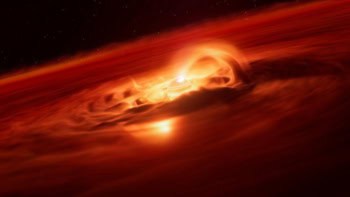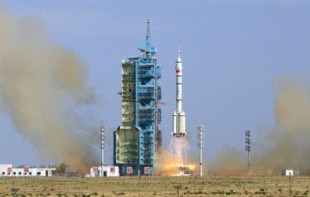The discovery of clusters of young stars in an old galaxy has challenged the accepted idea of how some galaxies evolve. An international team of astronomers studied an elliptical galaxy known as NGC 4365 using the Hubble Space Telescope and the Very Large Telescope in Chile, and were surprised to find that it bore the hallmarks of recent star formation. Most astronomers believe that the stars in elliptical galaxies are born during one intense period of star formation early in the lifetime of the galaxy.

Elliptical galaxies are usually reddish in colour, which suggests that the stars they contain are red giants – that is, stars that are in the late stages of stellar evolution. Unlike other types of galaxy, elliptical galaxies have few features – such as spiralling arms or lanes of dust – that would indicate recent activity. This smooth, red appearance has led astronomers to believe that the stars in each elliptical galaxy were formed at roughly the same time, very early in the galaxy’s history.
But now researchers have cast doubt on this view by combining visible and infrared images of galaxy NGC 4365 taken by the 8.2-metre VLT Antu telescope and the Hubble Wide Field and Planetary Camera 2. The observations centred on ‘globular clusters’ – clumps of stars that exist in and around every galaxy – linked with NGC 4365. Periods of star formation in the galaxy leave their mark on these clusters, so astronomers can track the galaxy’s history of star birth by studying them.
The new observations show that many of the globular clusters in NGC 4365 are only a few thousand million years old, in contrast with other stars in the galaxy that are thought to be about 12 thousand million years old. Spectroscopic studies also showed that these stars are also rich in metal. This supports the idea that the stars were born relatively recently when heavier elements – which were synthesized inside stars and then distributed into the interstellar medium by supernovas – were more abundant. In contrast, hydrogen and helium dominated the early Universe, so stars formed in this period contain much less metal.
Astronomers must now try to accommodate the discovery of young stars in old galaxies into theories of galaxy formation and the evolution of the Universe.
“It is a great pleasure to see VLT and Hubble work in concert to produce such an important scientific result,” says team member Piero Benvenuti. “The synergy between the most advanced ground and space telescopes continues to prove its effectiveness, paving the way to impressive new discoveries that would not otherwise be possible.”



